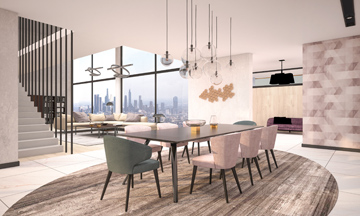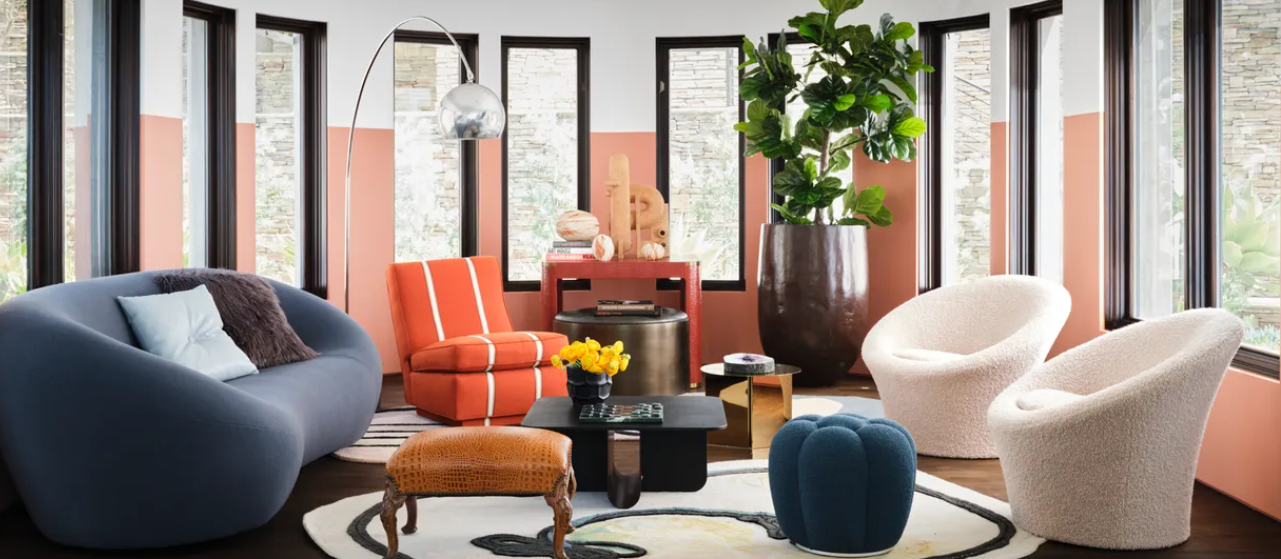
In the wake of major life changes, some empty-nesters are transforming their homes into fun and over-the-top abodes filled with new energy
We’re all familiar with the typical versions of the story: A couple send their kiddos off to college and suddenly find themselves without the need for every room in their full-size family home, so they downsize their home to a more reasonable, albeit less inviting, apartment. A recent widow decides to let go of the home she once shared with her partner, shedding double-occupancy status for the solace of a single-room or studio apartment. A couple in their mid-60s decide to move into a less extravagant home in anticipation of the lifestyle changes that accompany retirement. But that’s not the only way the story goes.
According to some designers, clients are increasingly responding to major life changes like retirement, widowhood, and empty nest-dom with a totally different tack. Call it fun-sizing: Instead of downsizing a home, they’re opting for energetic and exuberant design that breathes new life into the aesthetics and function of their nest. The goal is not to glaze over the real sense of loss and disruption that accompanies major transitions, but rather to displace the old with a more interesting and idiosyncratic new. It’s about shifting the surroundings in ways that support, and even celebrate, the positive aspects of change.
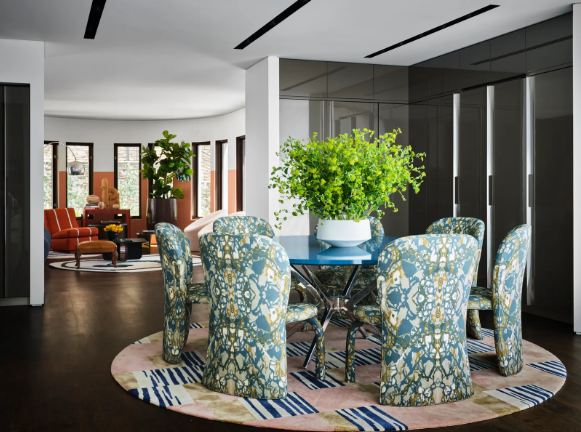
Take, for example, the cliff-hugging seaside home in Laguna Beach that AD100 designer Michelle Nussbaumer transformed into a maximalist manse. Inspired by the home’s dramatic proximity to the Pacific and guided by her clients’ desire to create a totally new experience for hosting their grandchildren, Nussbaumer eschewed the tropes of traditional family homes to create a remarkably patterned, imaginative, and wildly colorful fantasy abode. With features like a stenciled and high-contrast mural in the game room, a retro-futuristic Blackman Cruz leather swing chair in a curved living room window, a blotchy Rorschach-esque black-and-white marble dining room wall, and whimsically rotund Up chairs by Gaetano Pesce, the modern and more-is-more design is anything but ordinary. And it’s definitely not your stereotypical grandma’s house.
According to Nussbaumer, we’re entering “the era of the luxury fun house,” where vanilla properties go glam with the addition of amenities like multiple gyms, recreation spaces, home spas, playrooms, luxury boat docks with diving boards, slides, and lots of room for toys and games. This is especially true for older clients hoping to integrate their grandchildren’s interests into their home. “We’ve been asked to do a lot of theaters and concession stands lately,” she says. “We like to keep everyone busy and happy with activities for all ages: saunas, pickleball courts, smoothie bars, juice bars, cooking stations… We’ve even done several killer boxing gyms. Tree houses are fair game too.”
“Why not create your own fantasy vacation with all the bells and whistles? Life is short,” Nussbaumer says. “Let’s make it beautiful.”
Although most clients still want multigenerational family homes that cater to children, teenagers, and adults simultaneously, or some version of a fantasy vacation home, Nussbaumer notes an uptick in fun and not-so-conventional redesigns for senior-age clients over the past decade. Why might this trend be gaining traction? One possible answer is that it’s a way of combining both the family home and the fantasy vacation home into one unique cohesive option. Nussbaumer believes the trend took off during the COVID pandemic and quarantine, when both jet-setters and families—suddenly unable to travel—shifted focus to finding more ways to enjoy life at the home base. “We all realized how much fun it is to be together in our homes. Why not create your own fantasy vacation with all the bells and whistles? Life is short,” she says. “Let’s make it beautiful.”
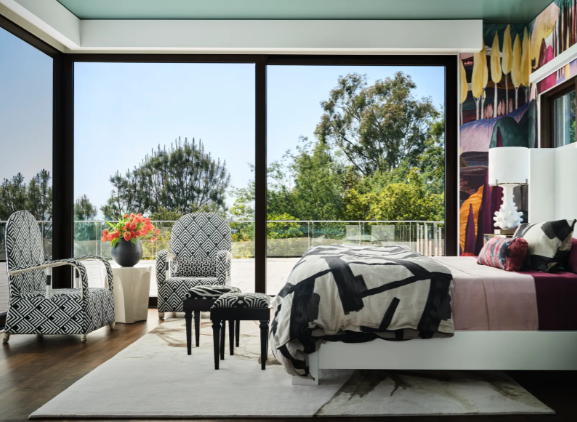
So whether they’re downsizing a home or building one from scratch, how can designers create a space that’s fun and safe for all ages? “We like to speak extensively with our clients to understand exactly how they live,” Nussbaumer says. “All my clients, including those who are grandparents, are very young at heart and active: still skiing, boating, sailing, and even skydiving. But they’re also thinking about what’s ahead, considering their next steps.” Her older clients usually want a private suite incorporated into the design—somewhere set apart, where they can sneak off and take care of business affairs during a family visit. She also considers needs that may arise in the future, like the mobility issues that can accompany aging, and seeks out discreet ways to incorporate ADA–friendly features. Nussbaumer advises designers working on similar projects to consider the safety of younger generations in addition to their entertainment. “We have to remember to design for the younger family members in these multigenerational homes too—toddlers running around a pool, for example—and consider the safety aspects of different materials. We don’t want anyone to slip and fall!”
In her 2022 book Home Therapy: Interior Design for Increasing Happiness, Boosting Confidence, and Creating Calm, interior designer and licensed therapist Anita Yokota walks readers through a system she developed for helping homeowners nurture their body, mind, and spirit through design. She explains that one of the primary goals of the book, and of her work in general, is to help others learn to “live in the gray”—that is, to help people come to terms with the perplexing and ever-changing nature of life. “Whether things work out or not, you have to remember that life circumstances can and often do change,” she says. “And when you set up your home appropriately, you can process what you’re feeling in the comforting cocoon of, say, a cozy chair surrounded by plants and calming colors while you learn to live more comfortably with uncertainty.” That concept rings even more true for people experiencing major life transitions like retirement, loss of loved ones, and the unfolding difficulties of aging.
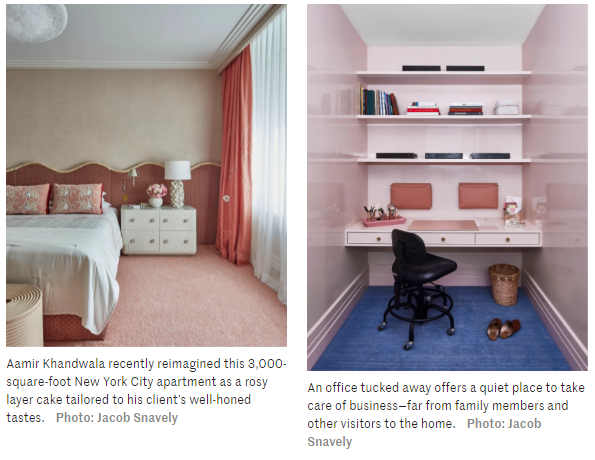
Roughly 77% of adults aged 50 and older would prefer to remain in their current homes for the rest of their lives, according to ongoing national polls conducted by the AARP. (That statistic has remained consistent for over a decade, despite the pandemic.) For most people, a sense of permanence provides peace of mind. But change is inevitable, and that sense of permanence will be disrupted, in some way or another, for everyone. And when it happens, interior designers are in a unique position to help clients embrace transition through reviving their surroundings.
“Most designers are very good at reading people. We’re therapists in a way.”
The key, according to designer Aamir Khandwala, is empathy. “Most designers are very good at reading people. We’re therapists in a way,” he says. “We get to know our clients intimately: their habits, routines, likes and dislikes…where they sit at different times of day, how they use each corner of a room. You have to think: What do I need to do to make that moment more pleasurable and comfortable?” It’s a process of learning about each client’s idiosyncrasies, then applying that knowledge in a way that can improve their lives day to day.
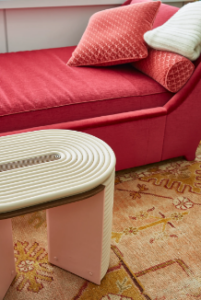
Khandwala’s clients range from 22 to 92 years old, and many in the older age bracket remain highly active. For them, he makes sure to include small design details that can improve their quality of life: sofa and armchair seat heights that reach at minimum 18 inches high for easy access, seating that falls on the firm side so clients don’t sink too deeply into plush materials, brighter lighting for increased visibility, and flooring softened with non-slip rugs and carpets. He says assessing the functionality of various materials is an important aspect of empathetic design—especially for older clients. That means choosing materials that not only look great but also bring warmth to bare floors and require little maintenance: performance velvet, wool or nylon carpets, jute and raffia rugs, and other high-performance materials that can make a huge impact. “There are a lot more materials to choose from now,” says Khandwala, who recommends mixing wool with natural textures like Sunpat—a hardy, sustainable, and raffia-like woven fiber used in rugs. “I look for warm, soft materials that can be cleaned easily. What kind of carpets would feel best when a client walks barefoot across the living room?”
But it’s not enough to only consider the ways in which someone’s physical abilities might diminish with age—there’s much more to the story. “In many ways, my older clients are easier to work with because they tend to be very cultured. They’ve lived rich lives, often in beautiful homes around the world,” Khandwala says. “Because of that wealth of experience, they know who they are and what they like.” But cultured tastes still crave newness, he points out, adding that these clients are often the most fearless when it comes to adventurous design and adopting new technologies.
“When clients are so well attuned to their own likes and dislikes, it allows me more freedom to focus on translating those preferences into beautiful functional spaces that reflect who they are.”
Khandwala recently redesigned the 3,000-square-foot Manhattan apartment of a longtime client after her son moved out and her husband passed away. A photographer and mental health advocate, the client had a well-established sense of style and a clear directive: to celebrate past memories while embracing her new solo future. Maximalist, playful, and particularly feminine, the redesign layered various textures and shades of pink, and mixed select elements from the homeowner’s past (including art, travel souvenirs, and furniture) with glamorous new features: a cobalt blue vintage Venetian bathroom mirror, a custom pink headboard trimmed with Samuel & Sons Silk fringe, and a made-to-order Herve Van der Straeten chandelier over the dining table. “She’s extremely vibrant and has a keen sense of adventure. When clients are so well attuned to their own likes and dislikes, it allows me more freedom to focus on translating those preferences into beautiful functional spaces that reflect who they are.”
Designing for changes like retirement, loss, and even normal challenges that come with aging requires a balance of two important but sometimes opposing goals: Pros must create a distinctive personal aesthetic while also evoking a genuine sense of novelty. How do you embrace major change without unsettling a home’s ongoing functionality or upsetting a client’s sense of familiarity? For Khandwala, it’s about understanding what clients are actually experiencing: “The key to being a good designer is keen listening.”
by Anna Elise Anderson (AD January 13, 2023)
